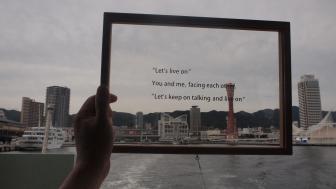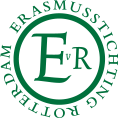Article
The port celebrates its 150th anniversary
Looking at Kobe through poetry - literally

August 20, 2017
To celebrate its 150th anniversary, the Port City Kobe Art Festival was held from September 16 to October 15 of this year. Artists from Japan and overseas were invited to display their works at the port. An Art Boat cruised off the shore, from which viewers could enjoy the combination of art with the city skyline, the Rokko Mountains serving as backdrop. One of the artists is Kazufusa Komaki, who was born near Kobe in 1967.
Komaki says that he wished to pull from “Kobe’s ‘bookshelf’ the voices of its poets, whose compositions reflect the history Kobe has been through”. He chose poems as the raw materials for his contribution to the festival titled “Nine pieces of poetry - Views of Kobe from the Sea”, selecting work by four poets, all of whom lived in Kobe at some time in their lives: Jūkichi Yagi (1898-1927), Jun Yamamura (1898-1975), {poet id="28688" title=“Iku Takenaka"} (1904-1982), and {poet id="28691" title=“Toshikazu Yasumizu"} (1931-). For Komaki, the voices of these poets form a genius loci, the spirit of the city of Kobe. For example, Yagi wrote:
The artist printed fragments of the poems on glass plates. The audience gets onboard the Art Boat and looks back at Kobe through the glass plates. What emerges in front of their eyes is the juxtaposition of the real landscape with lines of poetry, present-day Kobe seen through the layers of poets’ imaginations, a perspective they now share with all the voyagers who have ever arrived at or departed from the port of Kobe.
LINKS
Kobe festival site in English
Kazufusa Komaki
One hundred and fifty years ago in Japan, one thing was closing while another was opening. The Edo era, which enjoyed a so-called political Big Sleep - almost 300 years of diplomatic isolation under the rule of the Tokugawa Shogunate - was finally coming to an end. In the fall of 1867, with the resignation of the 15th and last Shogun, Yoshinobu Tokugawa, imperial rule was restored, a political upheaval triggered some fourteen years earlier by the unexpected appearance of four American warships off the coast of Edo, today called Tokyo.
At about the same time, the port of Kobe, 500 kilometers to the west of Tokyo and near the old capitals of Nara and Kyoto, was busy preparing for its new role. For centuries, the port had served as a transportation hub between the east and west of Japan and also to and from the Chinese continent and Korean peninsula. But as of January 1, 1868, the port for the first time in its history opened itself up to Western countries. This change marked the beginning of a new era, and the port soon became a window from which the Japanese people might view foreign cultures with great curiosity. The city of Kobe is now known for its rich international heritage.
To celebrate its 150th anniversary, the Port City Kobe Art Festival was held from September 16 to October 15 of this year. Artists from Japan and overseas were invited to display their works at the port. An Art Boat cruised off the shore, from which viewers could enjoy the combination of art with the city skyline, the Rokko Mountains serving as backdrop. One of the artists is Kazufusa Komaki, who was born near Kobe in 1967.
Komaki says that he wished to pull from “Kobe’s ‘bookshelf’ the voices of its poets, whose compositions reflect the history Kobe has been through”. He chose poems as the raw materials for his contribution to the festival titled “Nine pieces of poetry - Views of Kobe from the Sea”, selecting work by four poets, all of whom lived in Kobe at some time in their lives: Jūkichi Yagi (1898-1927), Jun Yamamura (1898-1975), {poet id="28688" title=“Iku Takenaka"} (1904-1982), and {poet id="28691" title=“Toshikazu Yasumizu"} (1931-). For Komaki, the voices of these poets form a genius loci, the spirit of the city of Kobe. For example, Yagi wrote:
In early winter,
I look down from a roof top garden.
The town of Kobe gives me
a look that is strangely off-putting
yet reminiscent of a streak of undeniable longing.
Only towards the mountain,
is it bright and clear as a fine autumn day.
Is it maybe because I'm looking down from a height?
What a pitiful sight it is with endless smoke rising gracelessly.
The town is evenly
coloured in dull steel blue
and appears disorderly.
I am pierced by an orderly streak of sorrow.
The poems were written from 1924 to 1995, and depict various moments in Kobe's history: the city in the heyday of the modernist movement and the post-World War I Taisho democracy; Kobe devastated by air raids during WWII, and on its way to recovery during the 1950's and 60’s; and Kobe devastated once again, this time by a magnitude 7.3 earthquake in 1995, which caused the death of more than 6,000 people. I look down from a roof top garden.
The town of Kobe gives me
a look that is strangely off-putting
yet reminiscent of a streak of undeniable longing.
Only towards the mountain,
is it bright and clear as a fine autumn day.
Is it maybe because I'm looking down from a height?
What a pitiful sight it is with endless smoke rising gracelessly.
The town is evenly
coloured in dull steel blue
and appears disorderly.
I am pierced by an orderly streak of sorrow.
The artist printed fragments of the poems on glass plates. The audience gets onboard the Art Boat and looks back at Kobe through the glass plates. What emerges in front of their eyes is the juxtaposition of the real landscape with lines of poetry, present-day Kobe seen through the layers of poets’ imaginations, a perspective they now share with all the voyagers who have ever arrived at or departed from the port of Kobe.
LINKS
Kobe festival site in English
Kazufusa Komaki
© Yasuhiro Yotsumoto
Sponsors
























